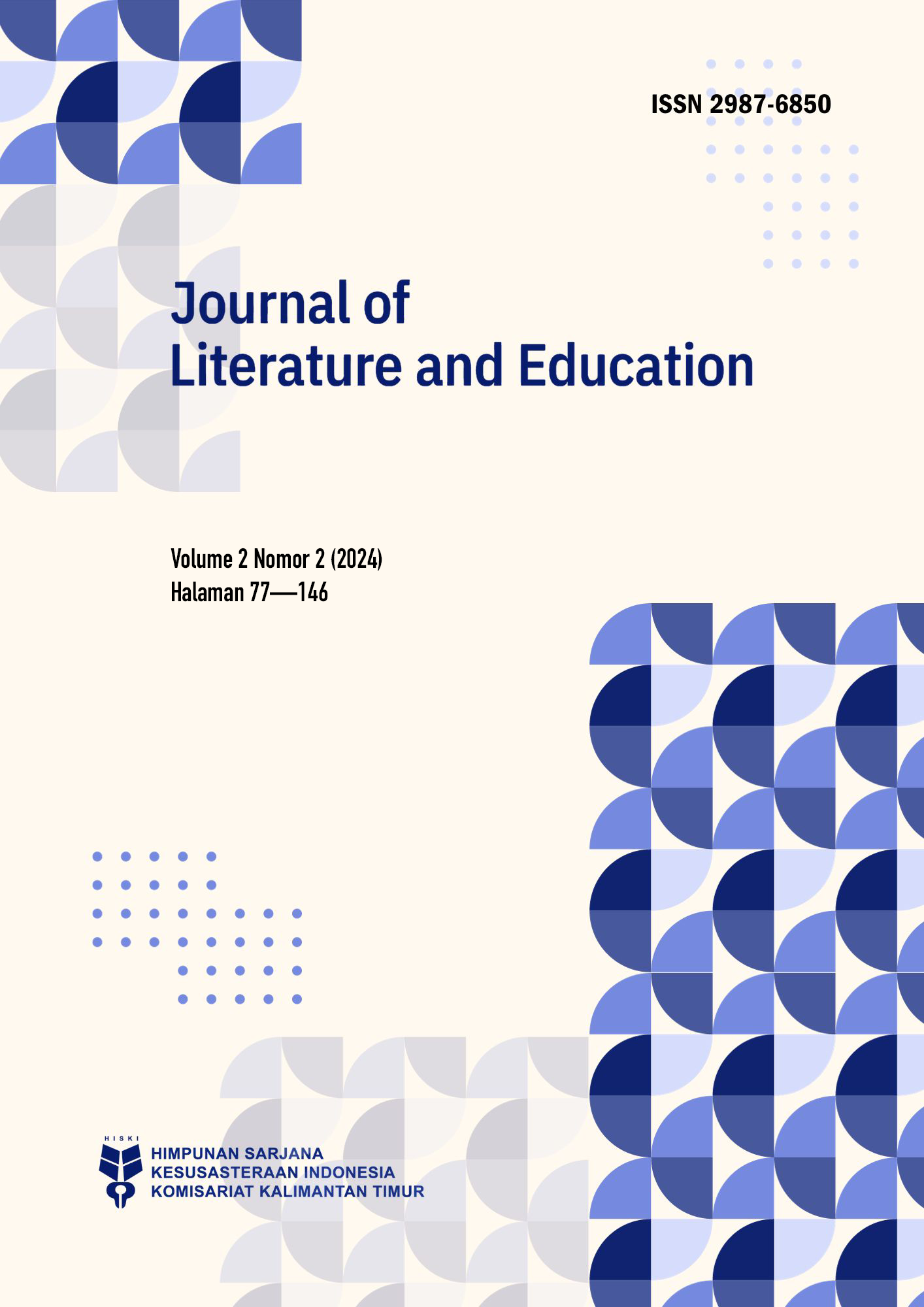The Analysis of Setting and Atmosphere on The Old Man and the Sea Analisis terhadap latar dan suasana dalam “The Old Man and the Sea”
Main Article Content
Abstract
A good story is not only formed from the plot but can also be formed from the development of setting and atmosphere. This research wants to see how setting and atmosphere can play an active role in shaping and building a story. Especially in the story The Old Man and the Sea. This research is based on the book by E. M. Forster which examines the elements in the novel in his book, namely Aspects of the Novel. This research uses a descriptive qualitative method so that the results of this research are described descriptively and in detail. In the story The Old Man and the Sea, the author uses temporal setting to make the story completely dependent on the setting. So, the novel The Old Man and the Sea is formed from plot development that depends on the setting.
Article Details

This work is licensed under a Creative Commons Attribution-ShareAlike 4.0 International License.
Under the following terms:
Attribution — You must give appropriate credit, provide a link to the license, and indicate if changes were made. You may do so in any reasonable manner, but not in any way that suggests the licensor endorses you or your use.
ShareAlike — If you remix, transform, or build upon the material, you must distribute your contributions under the same license as the original.
References
Adampe, R. Y. (2015). Tinjauan Sosiologis terhadap Novel Detik Terakhir Karya Alberthiene Endah [Universitas Sam Ratulangi]. https://ejournal.unsrat.ac.id/v3/index.php/jefs/article/view/8872
Aliyev, A. (2021). What Is a Novel? Estetika: The European Journal of Aesthetics, LVIII/XIV(1), 19–34. https://doi.org/10.33134/eeja.215
Altmann, U., Bohrn, I. C., Lubrich, O., Menninghaus, W., & Jacobs, A. M. (2014). Fact vs Fiction—How Paratextual Information Shapes Our Reading Processes. Social Cognitive and Affective Neuroscience, 9(1), 22–29. https://doi.org/10.1093/scan/nss098
Andriana, N., & Rohmah, O. (2019). The Character and Setting in the Novel “About You” By Tere Liye. INFERENCE: Journal of English Language Teaching, 2(2), 151–158. https://journal.lppmunindra.ac.id/index.php/inference/article/view/5996
Bhattarai, K. (2023). Non-Human World in Ernest Hemmingway’s The Old Man and the Sea. Journal of Tikapur Multiple Campus, 6(June), 94–106. https://doi.org/10.3126/jotmc.v6i01.56359
Farooqui, R. (2021). An Analysis of Santiago’s Character in Hemingway’s The Old Man and the Sea?: A Saga of Indomitable Human Spirit. International Journal of Linguistics, Literature and Translation, 4(5), 184–188. https://doi.org/10.32996/ijllt.2021.4.5.20
Hossain, M. (2018). Solitude and its Language Manifestation in Ernest Hemingways The Old Man and the Sea: A Psycholinguistic Inspection. International Journal of English Language and Literature Studies, 7(3), 75–80. https://doi.org/10.18488/journal.23.2018.73.75.80
Istiqomah, N., Doyin, M., & Sumartini. (2014). Sikap Hidup Orang Jawa dalam Novel Orang-Orang Proyek Karya Ahmad Tohari. Jurnal Sastra Indonesia, 3(1), 1–9. https://journal.unnes.ac.id/sju/jsi/article/view/3964
Khan, M. E. I. (2014). Professionalism in Ernest Hemingway’s The Old Man and the Sea. International Journal of Research, 1(9), 554–562. https://journals.pen2print.org/index.php/ijr/article/view/665
Lian-feng, C. (2015). A Perfect Combination of the Real Life and Literary World: An Analysis of The Old Man and the Sea. Sino-US English Teaching, 12(10), 802–805. https://doi.org/10.17265/1539-8072/2015.10.009
Murni, A. W., & Purwanto, W. P. E. (2019). Tema dan Fakta-Fakta Cerita dalam Novel Dari Tanah Haram ke Ranah Minang Karya Ummuki. PIKTORIAL: Journal of Humanities, 1(2), 132–137. https://openjournal.unpam.ac.id/index.php/PTL/article/view/3772
Mutia, T. R. (2021). An Analysis of Educational Values in Ernest Hemingway’s The Old Man and the Sea [IAIN Ponorogo]. https://etheses.iainponorogo.ac.id/17696/
Reyns-Chikuma, C., & Lazreg, H. Ben. (2017). Marjane Satrapi and the Graphic Novels from and about the Middle East. Arab Studies Quarterly, 39(1), 758–775. https://doi.org/10.13169/arabstudquar.39.1.0758
Sandamali. (2015). Symbolism In Ernest Hemingways The Old Man and the Sea. International Journal of Scientific & Technology Research, 4(12), 125–129. https://www.ijstr.org/final-print/dec2015/Symbolism-In-Ernest-Hemingways-The-Old-Man-And-The-Sea.pdf
Shahwan, S. J. (2019). A Lacanian Study of Hemingway’s The Old Man and the Sea. Mediterranean Journal of Social Sciences, 10(1), 87–91. https://doi.org/10.2478/mjss-2019-0009
Thakur, K. S. (2022). Santiago in Hemingways Novel: The Old Man and the Sea-Authenticity Transcends Lostness– An Existential Survey. International Journal for Research in Applied Science and Engineering Technology, 10(5), 5140–5141. https://doi.org/10.22214/ijraset.2022.43641
Therese, T. M. (2015). Setting, Characters and Diction in Fiction. Journal of Literature, Languages and Linguistics, 6, 44–49. https://iiste.org/Journals/index.php/JLLL/article/view/19326
Wan, Y. (2019). On the Manhood in face of Tragedy Theme of The Old Man and the Sea. Sser, 402–404. https://doi.org/10.25236/sser.2019.072
Zinnah, N. J. B. (2022). The Social Image Crisis of Santiago and Captain Ahab: A Psychoanalytic Comparison between The Old Man and the Sea and Moby-Dick. Green University Review of Social Sciences, 7(1–2), 175–187. https://doi.org/10.3329/gurss.v7i1-2.62693

